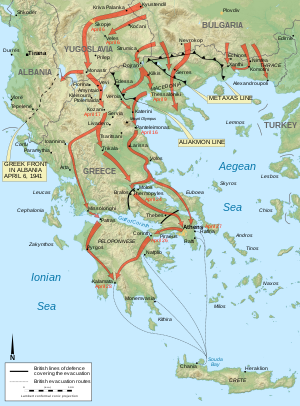Greek campaign
| Battle of Greece | |||||||||
|---|---|---|---|---|---|---|---|---|---|
| Part of the Balkans Campaign during World War II | |||||||||
 Nazi Germany's attack on Greece |
|||||||||
|
|||||||||
| Belligerents | |||||||||
|
Axis: |
Allies: |
||||||||
| Commanders and leaders | |||||||||
|
|
|
||||||||
| Strength | |||||||||
|
Germany: 680,000 men 1,200 tanks 700 aircraft 1Italy: 565,000 men 463 aircraft 163 tanks Total: 1,245,000 men |
1Greece: 430,000 men 20 tanks British Empire: 262,612 men 100 tanks 200–300 aircraft |
||||||||
| Casualties and losses | |||||||||
|
1Italy: 13,755 dead 63,142 wounded 25,067 missing 3Germany: 1,099 dead 3,752 wounded 385 missing |
1Greece: 13,408 dead 42,485 wounded 1,290 missing British Empire: 903 dead 1,250 wounded 13,958 captured |
||||||||
|
1Statistics about the strength and casualties of Italy and Greece refer to both the Greco-Italian War and the Battle of Greece (at least 300,000 Greek soldiers fought in Albania). |
|||||||||
| Battle of Greece Timeline | |
|---|---|
| 6 April | The German armies invade Greece. |
| 8 April | The German 164th Infantry Division captures Xanthi. |
| 9 April | German troops seize Thessaloniki. The German 72nd Infantry Division breaks through the Metaxas Line. The Greek army in Macedonia capitulates unconditionally. |
| 10 April | The Germans overcome the enemy resistance north of Vevi, at the Klidi Pass. |
| 13 April | General Wilson decides to withdraw all British forces to the Haliacmon river, and then to Thermopylae. Elements of the Greek First Army operating in Albania withdraw toward the Pindus mountains. Hitler issues his Directive No. 27, which illustrates his future policy of occupation in Greece. |
| 14 April | The spearheads of the 9th Panzer Division reach Kozani. After fighting at Kastoria pass, the Germans block the Greek withdrawal, which extends across the entire Albanian front. |
| 16 April | Wilson informs General Papagos of his decision to withdraw to Thermopylae. |
| 17 April | Rear admiral H. T. Baillie-Grohman is sent to Greece to prepare for the evacuation of the Commonwealth forces. |
| 18 April | After a three-days struggle, German armored infantry crosses the Pineios river. The 1st SS Division Leibstandarte SS Adolf Hitler—which had reached Grevena— overwhelms several Greek units. |
| 19 April | German troops enter Larissa and take possession of the airfield. German troops capture Ioannina. |
| 20 April | The commander of the Greek forces in Albania, General Georgios Tsolakoglou, offers to surrender his army to the Germans alone. The Bulgarian Army occupies most of Thrace. |
| 21 April | The final decision for the evacuation of the Commonwealth forces to Crete and Egypt is taken. The Germans capture the port of Volos. |
| 23 April | Official surrender of the Greek forces in Albania to both the Germans and the Italians after a personal representation from Mussolini to Hitler |
| 24 April | The Germans attack the Commonwealth forces at Thermopylae. The British rear guards withdraw to Thebes. 5,200 Commonwealth soldiers are evacuated from Porto Rafti, East Attica. |
| 25 April | The few RAF squadrons leave Greece. Some 10,200 Australian troops are evacuated from Nafplio and Megara. The Germans stage an airborne operation to seize the bridges over the Corinth Canal. |
| 27 April | The first Germans enter Athens. |
| 28 April | Italian troops start occupying the Ionian and Aegean islands. |
| 29 April | 5th Panzer Division units reach the south coast of Peloponnese, where they are joined by SS troops arriving from Pyrgos. |
| 30 April | The evacuation of 42,311 Commonwealth soldiers is completed. The Germans manage to capture around 7-8,000 Commonwealth troops. |
1Statistics about the strength and casualties of Italy and Greece refer to both the Greco-Italian War and the Battle of Greece (at least 300,000 Greek soldiers fought in Albania).
2Including Cypriots and Mandatory Palestinians. British, Australian and New Zealand troops were c. 58,000.
The Battle of Greece (also known as Operation Marita, German: Unternehmen Marita) is the common name for the invasion of Allied Greece by Nazi Germany in April 1941 during World War II. Concomitant to the stalled Greco-Italian War, it is usually distinguished from the Battle of Crete, which came after mainland Greece had been subdued. These Axis operations were part of the greater Balkan Campaign of Germany.
At the time of the German invasion, Greece was at war with Fascist Italy, following the Italian invasion on 28 October 1940. The Greeks joined the Allies and defeated the initial Italian attack and the counter-attack of March 1941. When Operation Marita began on 6 April, the bulk of the Greek Army was on the Greek border with Albania, then a protectorate of Italy, from which the Italian troops had attacked. German troops invaded from Bulgaria, creating a second front. Greece had already received a small, inadequate reinforcement from British Empire forces in anticipation of the German attack, but no more help was sent afterward. The Greek army found itself outnumbered in its effort to defend against both Italian and German troops. As a result, the Metaxas defensive line did not receive adequate troop reinforcements and was quickly overrun by the Germans, who then outflanked the Greek forces at the Albanian border, forcing their surrender. The British Empire forces were overwhelmed and forced to retreat, with the ultimate goal of evacuation. For several days, Allied troops played an important part in containing the German advance on the Thermopylae position, allowing ships to be prepared to evacuate the units defending Greece. The German Army reached the capital, Athens, on 27 April and Greece's southern shore on 30 April, capturing 7,000 British Empire forces and ending the battle with a decisive victory. The conquest of Greece was completed with the capture of Crete a month later. Following its fall, Greece was occupied by the military forces of Germany, Italy and Bulgaria.
...
Wikipedia
